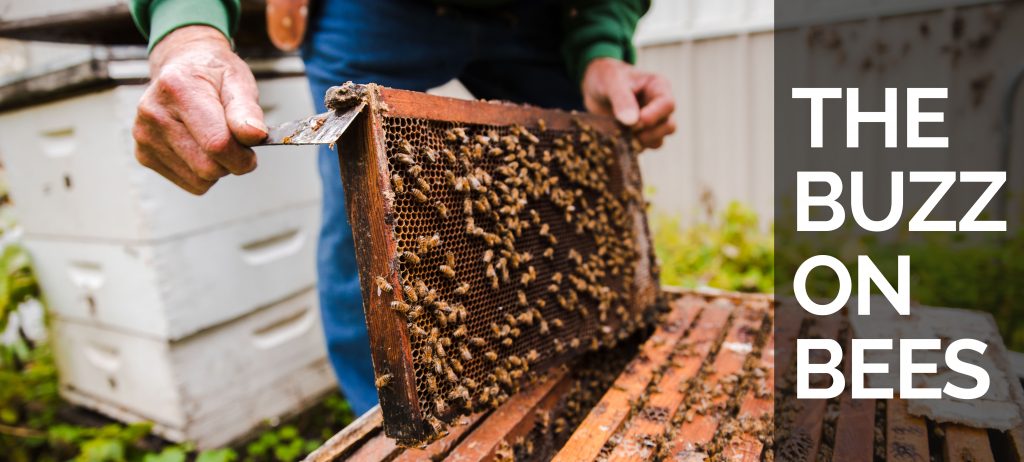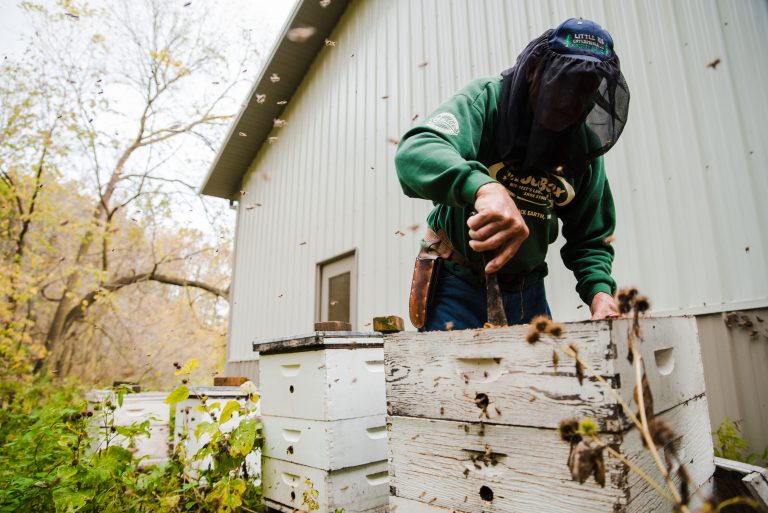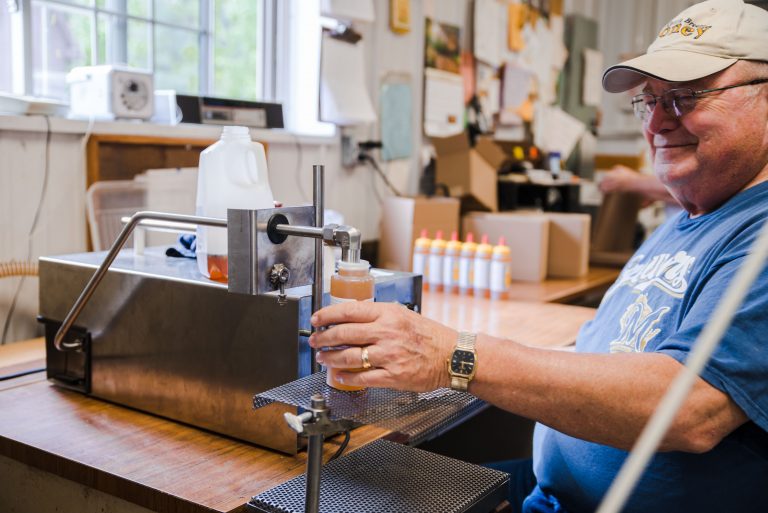
Eugene Woller places a navy blue baseball cap on his head, wraps a work belt around his waist and treks up the dirt road, muddy from the week’s relentless thunderstorms.
As Woller approaches the white boxes, he secures a thin, mesh veil over his hat, covering his face and neck. Using a paint scraper pulled from his belt, Woller pries open the top of one of the white, wooden boxes. Inside are rows of wooden frames, each dancing with movement. With bare hands, he pulls out a frame, exposing hundreds of buzzing honeybees.
The bees crawl over his fingers, but Woller doesn’t seem to mind. As he continues to examine them, he pays no attention to the haze of thousands of bees buzzing around him.
Woller picks up a single bee in his bare hands, weathered from more than 50 years of beekeeping.
“Let’s see if we can get this one to sting my hand,” Woller says.
He spends the next few moments attempting to get the bee to sting the back of his hand so he can demonstrate how to properly remove a stinger.
“If they’re a young bee, they really don’t want to — you have to really push them.”
Moments later, Woller says, “There! She just stung me.”
Young bees are hesitant to sting without a strong reason to — after they sting, they die. Woller’s willingness to take a bee sting stems from his passion for teaching about beekeeping.
For many of us, the prospect of a bee sting is harrowing and frightening. But to beekeepers, a sting represents the symbiotic relationship they have with the hive. A bee sting is nothing to be afraid of, Woller shows, but rather, is synonymous with perseverance and dedication.
That passion for honeybees is based on the essential role they play cultivating our food supply by pollinating crops. More than 90 percent of crops in the U.S. depend on bees to pollinate them. But the bees are facing more challenges than ever, from a lack of food to invasive insects and heavy chemicals in agriculture. Although beekeepers may have differing opinions on maintaining and caring for their hives, the beekeeping community of Wisconsin agrees on one major thing: the importance of bees.
Woller, 72, has been beekeeping for almost three-quarters of his life, since Lyndon B. Johnson was president and before man walked on the moon. The man knows honeybees so well he willingly inflicted two bee stings upon himself during an interview. With 53 years of experience under his belt, Woller knows the ins and outs of the honey business.
Woller owns Gentle Breeze Honey, based just outside Madison in Mount Horeb, Wisconsin. The farm produced more than 47,000 pounds of honey this year from approximately 600 hives. The large, sheet-metal barn on Woller’s farm is filled with boxes and barrels of honey. Some boxes are filled with 8-ounce honey bears, others are packed with jugs for distribution to local businesses. Each package is dutifully labeled in black permanent marker.“We just want a quality product,” he says. “So far, it’s been good. We’ve been at it 50-some years … and it’s been good. The bees have been good to us.”
As is the case for any profession or hobby, not everyone beekeeps the same way.
“If you ask 10 beekeepers the same question, you’ll probably get 11 different opinions,” says Hannah Sjostrom, the 2018 Wisconsin Honey Queen, an ambassador and spokeswoman for the industry on behalf of the Wisconsin Honey Producers Association.
She promotes the industry and educates people throughout Wisconsin on beekeeping. Other events the association hosts are a booth at the Wisconsin State Fair, spring meetings across the state and its annual statewide convention in the fall.
Sjostrom is a third-generation beekeeper, following in the footsteps of her parents and grandparents. But at age 20, Sjostrom is much younger than many practicing beekeepers in Wisconsin.
“A lot of the people have been in it for a long, long time,” Sjostrom says. “The older generation … they’ve kept [it] up the whole time.”
Steadfast beliefs bring resistance to change.
“A lot of beekeepers don’t always like change,” Sjostrom says. “But it’s kind of part of the business.”
Kent Pegorsch, president of the Wisconsin Honey Producers Association, guides the group in creating a bond between commercial beekeepers and hobbyists in Wisconsin through a variety of engagement projects. He has also been a beekeeper for 42 years, since he was 16.
Pegorsch notes that not all beekeepers in Wisconsin operate the same way. They make different decisions regarding their bees, which may lead to more or less involvement in the statewide organization. Speaking on behalf of the association, he says its membership views bees as domesticated animals. The Dane County organization, he says, has a more natural approach.
One area of disagreement is management of the Varroa mite, an insect that emerged in the U.S. in the 1980s. The mites weaken bees by making them more susceptible to viruses.
“We feel strongly that you must maintain the bees a certain way. You must manage them for the Varroa mite,” says Pegorsch. “Some organizations around the state take a more ‘live and let die’ kind of approach.”
It doesn’t take long to find someone with a “live and let die” approach in the Madison area. Heather Swan, a lecturer teaching environmental literature and writing at UW-Madison, is an avid beekeeper. In 2017, she published “Where Honeybees Thrive,” a creative nonfiction book narrating the search for the sources and solutions to modern-day bee problems.
“I’m not a person that’s doing much to my hives,” Swan says. “If we let the bees do what they normally do, what they would naturally do … we don’t need to treat bees.”
Swan acknowledges that her opinion may be contentious.
“I don’t want to criticize anybody that’s doing what they’re doing, because that’s the way we’ve always done it,” Swan says. “But I’m really excited about the new possibilities.”
Though Pegorsch takes a more hands-on approach and manages his colonies more than Swan, he says beekeepers today are more in tune with their colonies than the previous generation.
“When I first started, you got the colonies, you put the boxes on, you harvest the honey, and that was pretty much it,” Pegorsch says.
Given a lack of forage, or food for the bees, the Varroa mite and chemical use, the odds are stacked against the honeybees.
“Those are … the three things that are really a trifecta now, that are kind of crescendoing now over the last decade or two. And that’s what’s causing a lot of our challenges in beekeeping,” Pegorsch says.
As crop fields expand, the fence rows bordering them, where wildflowers and native grasses once grew, are disappearing. Now, honeybees and other native pollinators, such as butterflies, are struggling to find food.
“One of the biggest issues is that they don’t have enough to eat — and this is native bees, also,” Swan says.
Jeanne Hansen, a retired beekeeper, believes her bees weren’t healthy because they were constantly starving.
“I think they were always on the ragged edge of nothing,” Hansen says.
The Varroa mite is another challenge, living and feeding off the bees, creating a way for viruses to attack the bees and shortening their lifespan. The Varroa mite comes up almost every time beekeepers talk about their struggles.
At a recent meeting of the Dane County Beekeepers Association, members discussed how difficult it’s been this season to fight the mites. Going around in a circle, each beekeeper tells a story, their peers nodding as they discuss Varroa mites or detail the heartbreak of an unsuccessful honey harvest.
“No matter what I tried, the bees would die over winter. They’ve got mites, and they’ve got virus diseases,” Hansen says.
And then there are the heavy chemicals from agriculture that have put an increased strain on the bees.
“We’re dealing with insecticides and pesticides that we’ve never dealt with before,” Woller says.
Many modern pesticides no longer outright kill bees when sprayed over fields, like their predecessors did. Instead, these chemicals produce a “sublethal effect” — the dose of pesticides the bees are exposed to is not enough to kill them immediately, but has delayed effects. The pesticides impair bees cognitively, making it difficult for them to gather nutrients and navigate a successful return to their hive.







A honeybee queen used to have a lifespan of three to five years. Now, the longest a beekeeper can expect a queen to survive in a hive is two years. Often, the queen is replaced every year because the chemical burden on the hive is shortening the lifespan of the queen and affecting how fertile she is.
“If you drank a little bit of poison each day, it may not kill you. But if you keep on drinking poison every day, a little bit of it, sooner or later it’s going to shorten your life,” Pegorsch says. “That’s kind of what we’re facing with the bee colonies out there.”
Wisconsin beekeepers are diligently working to educate their communities on the critical importance and necessity of honeybees.
“Bees are creatures that a lot of people don’t understand,” Swan says.
Perhaps the biggest misconception about honeybees? They’re extremely passive creatures.
Sjostrom’s position allows her to travel around the state to spread awareness and information about beekeeping. She knows that many people don’t understand the importance of bees — they only view them as threatening.
“People don’t really realize that honeybees are super docile, and that actually, when you get stung outside, it most likely is not from a honeybee,” Sjostrom says. “Honeybees can only sting once and then they die, and so they really don’t like to sting unless you’re provoking their hive.”
Despite the tough conditions beekeepers face right now, they have high hopes for the future, in part because of meticulous measures they’re taking to improve the health of their bees. To do it, they’re building close relationships with their hives.
“I try really hard to listen to what the bees need,” Swan says.

Sofia, a lead writer, is a senior studying strategic communication with certificates in gender and women's studies and digital studies. While buzzing insects weren't always her favorite, she grew to love bees while reporting this story.